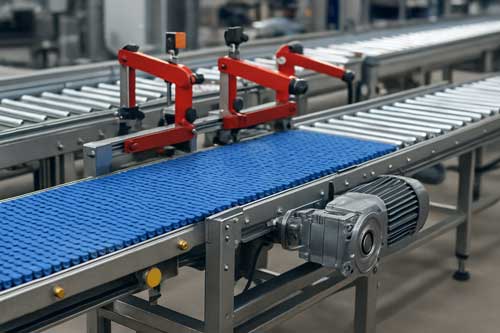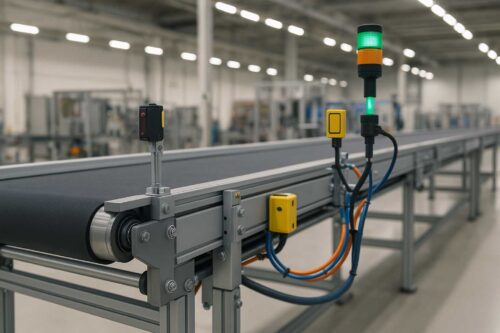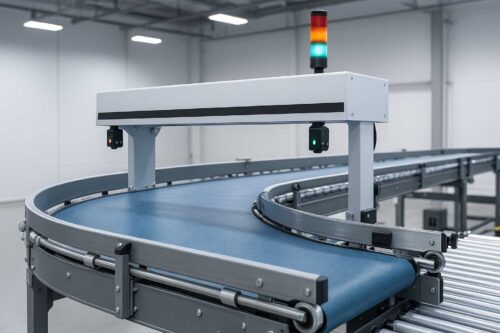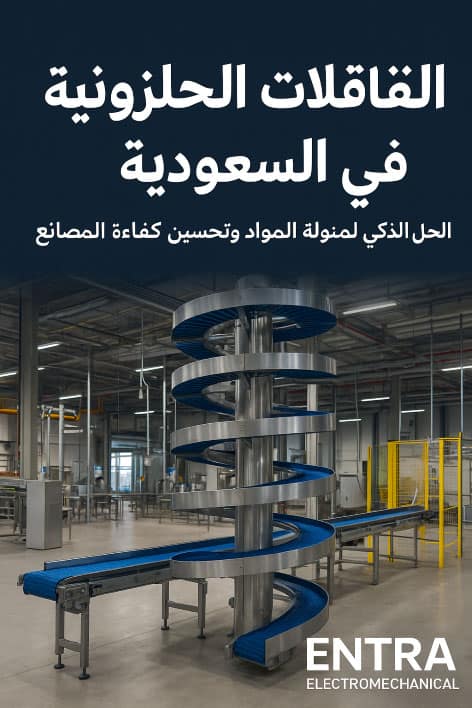
Unlocking Efficiency: How Conveyor Accessories Elevate Material Handling Performance
August 4, 2025
Automation Trends Transforming Conveyor Systems in 2025
August 7, 2025Smart Conveyor Systems: How They’re Transforming Material Handling
In today’s industrial world, where every second of downtime can lead to thousands of dollars in losses, businesses are looking for advanced technologies to optimize their production lines and reduce inefficiencies.


Among the many innovations redefining the manufacturing landscape, smart conveyor systems stand out as one of the most effective tools to improve material flow, reduce human error, and boost overall productivity. These systems, which combine traditional mechanical conveyors with modern automation technologies, are quickly becoming the backbone of material handling equipment in leading factories and warehouses.
At their core, smart conveyor systems are built to do more than move materials from one point to another. They are designed with embedded sensors, automated controls, machine learning capabilities, and IoT (Internet of Things) connectivity.
These additions allow the system to collect real-time data on conveyor load, motor performance, belt tension, and even environmental conditions like temperature and humidity. This data is then analyzed to make autonomous decisions that improve system efficiency, alert maintenance teams before failures occur, and adjust speeds or routing paths based on production demands.
The integration of smart conveyor systems with existing ERP (Enterprise Resource Planning), WMS (Warehouse Management Systems), and MES (Manufacturing Execution Systems) platforms creates a level of interconnectivity that allows for full visibility across operations.
One of the key advantages of automated conveyor systems lies in their predictive maintenance capabilities. In traditional conveyor setups, maintenance is typically reactive. You wait until something breaks before fixing it.
This approach leads to unplanned downtimes, urgent labor costs, and potential safety risks. In contrast, smart conveyor systems are equipped with vibration sensors and motor diagnostics that detect early signs of mechanical wear, belt misalignment, or component fatigue.
These insights allow maintenance teams to schedule interventions before catastrophic failures occur, leading to reduced downtime, longer equipment lifespan, and optimized resource allocation.
In industries like automotive, pharmaceuticals, food and beverage, and e-commerce, smart conveyor systems are proving essential in ensuring product traceability, quality control, and efficient sorting.
In pharmaceutical plants, for example, smart conveyors maintain cleanroom standards while automatically adjusting speed to accommodate different drug batches. In e-commerce fulfillment centers, they scan and sort parcels in real time, directing them to the appropriate dock or packing station without manual intervention.
Such dynamic systems also include touchless HMI (Human-Machine Interface) panels and AI-based routing algorithms that constantly adapt to shifting production goals.
A real-world example of smart conveyor systems in action is the implementation by ENTRA Electromechanical in a packaging facility located in Giza, Egypt. This forward-thinking company, known for its robust industrial conveyors, installed an end-to-end smart conveyor system featuring modular belts, optical sensors, and a cloud-based monitoring dashboard.
The results were significant: the client saw a 15% increase in production throughput within the first month, while unplanned maintenance calls dropped by 27%. Additionally, the system’s full integration with their warehouse management system allowed for real-time inventory updates and streamlined order fulfillment.
Another strong feature of smart conveyor systems is their scalability and flexibility. Whether you’re handling pallets, cartons, or fragile electronics, these systems can be tailored to suit specific needs.
Adjustable guides, automatic speed modulation, and load-specific handling units ensure gentle but efficient movement of goods across the facility. What’s more, smart conveyors are increasingly being manufactured with sustainability in mind.
Low-energy motors, regenerative drives, and intelligent idling features contribute to reducing the environmental footprint of large industrial operations—an essential consideration as more companies strive to meet global sustainability goals.
From a technological standpoint, smart conveyor systems leverage edge computing, AI, and digital twin simulations to ensure optimal performance.
Edge AI enables quick decision-making without needing to rely on cloud computing, which reduces latency and boosts reliability in time-sensitive operations.
Digital twin technology allows engineers to simulate how the conveyor will perform under different load conditions, making it easier to identify bottlenecks before they become real-world problems.
As these technologies continue to evolve, smart conveyor systems are expected to become more autonomous, predictive, and adaptable to diverse environments.
Looking at the market trends, we’re witnessing a growing demand for smart conveyor systems across the Middle East, particularly in Egypt, Saudi Arabia, and the UAE.
Manufacturers in these regions are rapidly modernizing their production lines to keep pace with global competition, and material handling is a critical part of this transformation. According to recent industry reports, facilities that adopt automated material handling equipment, including smart conveyor systems, report up to 30% reduction in operational costs within the first year.
This clearly underscores the value proposition of investing in these systems—not only for large-scale manufacturers but also for mid-sized businesses looking to scale efficiently.
In terms of conveyor accessories, smart systems are often paired with barcode scanners, RFID readers, weigh scales, diverters, and even robotic arms.
These accessories enhance system capabilities and provide additional layers of intelligence and automation. For example, a conveyor can be programmed to weigh and sort products simultaneously, or to divert items based on RFID-tagged shipment instructions.
This level of automation minimizes human error, accelerates workflows, and ensures compliance with strict industry regulations.
Despite all these advantages, selecting the right smart conveyor system requires careful planning. Decision-makers must consider factors such as system compatibility, scalability, sensor accuracy, and vendor support.
Customization is also crucial. For example, in food processing plants, conveyor materials must meet hygiene standards and withstand frequent washdowns.
In electronics manufacturing, conveyors must be anti-static and sensitive to micro-vibration impacts. Choosing a vendor with deep expertise in the domain—like ENTRA Electromechanical—can help businesses navigate these technical challenges effectively.
Smart conveyor systems are also key players in the broader context of Industry 4.0 and digital transformation. As factories evolve into smart factories, the role of automated conveyor systems expands beyond mere transportation.
They become data hubs, safety enforcers, and workflow optimizers. In this context, companies that embrace smart conveyor technologies today are not just upgrading their equipment—they’re future-proofing their operations against global supply chain disruptions, labor shortages, and increased market demands.
The future of smart conveyor systems is bright and dynamic. We’re already seeing experimental designs like autonomous conveyor drones that move between floors, voice-activated control units, and machine vision systems that detect product defects during transit.
As AI becomes more accessible and affordable, smart conveyor systems will gain cognitive capabilities—learning patterns from past data, optimizing routes in real time, and even predicting future maintenance requirements without human input. It’s a powerful shift from reactive to proactive logistics.
In conclusion, smart conveyor systems represent a leap forward in material handling solutions. They bring together the best of mechanical engineering, digital automation, and real-time analytics to deliver unparalleled efficiency, safety, and scalability.
For manufacturers, logistics companies, and distribution centers aiming to stay ahead in a highly competitive market, investing in smart conveyor systems is no longer optional—it’s a strategic necessity. Whether you’re modernizing an existing facility or building a new one, integrating smart conveyors can redefine your operational performance and pave the way for long-term growth.




